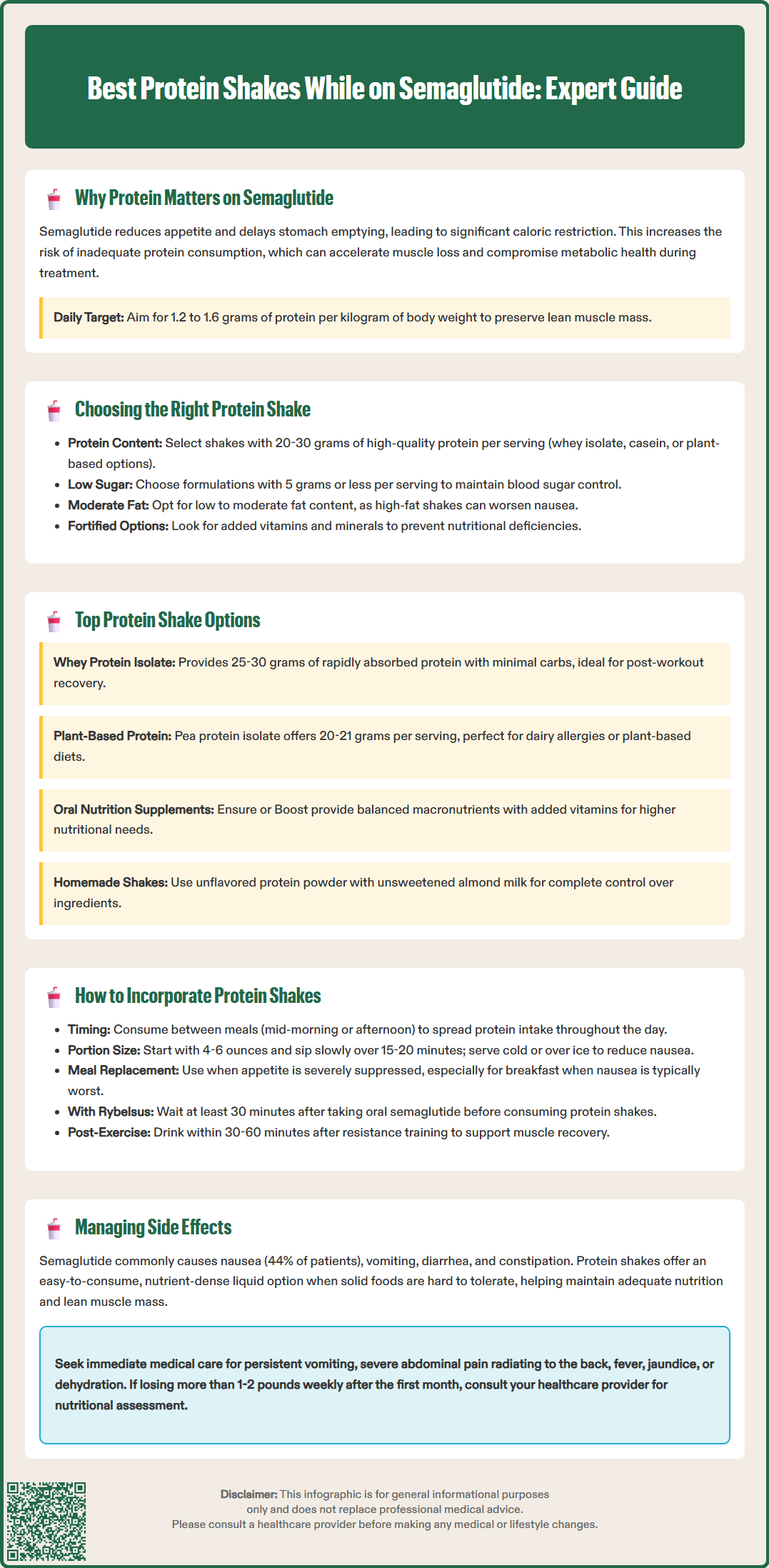LOSE WEIGHT WITH MEDICAL SUPPORT — BUILT FOR MEN
- Your personalised programme is built around medical care, not willpower.
- No generic diets. No guesswork.
- Just science-backed results and expert support.
Find out if you’re eligible

Semaglutide (Ozempic, Wegovy, Rybelsus) effectively manages type 2 diabetes and supports weight loss by reducing appetite and delaying gastric emptying. However, these effects can make meeting daily protein needs challenging, increasing the risk of muscle loss during caloric restriction. Protein shakes offer a practical solution for maintaining adequate protein intake—typically 1.2 to 1.6 grams per kilogram of body weight daily—when appetite is suppressed. Selecting the right protein shake requires consideration of protein content, digestibility, sugar levels, and individual tolerance to support lean body mass preservation during semaglutide treatment.
Quick Answer: The best protein shakes while on semaglutide provide 20 to 30 grams of high-quality protein per serving with low sugar content and are easily digestible to accommodate delayed gastric emptying.
Semaglutide is a glucagon-like peptide-1 (GLP-1) receptor agonist approved by the FDA for type 2 diabetes management (under brand names Ozempic and Rybelsus) and chronic weight management (Wegovy). By mimicking endogenous GLP-1, semaglutide enhances glucose-dependent insulin secretion, suppresses glucagon release, and delays gastric emptying. These mechanisms contribute to improved glycemic control and significant appetite reduction, often resulting in substantial caloric restriction.
During semaglutide therapy, many patients experience marked decreases in appetite and early satiety, which can lead to reduced overall food intake. While this caloric deficit supports weight loss, it also increases the risk of inadequate protein consumption. Protein is essential for preserving lean body mass during weight reduction, supporting immune function, maintaining skin integrity, and facilitating wound healing. Studies examining rapid weight loss consistently demonstrate that insufficient protein intake accelerates muscle loss, which can compromise metabolic health and functional capacity.
The American Diabetes Association recommends individualized nutrition therapy for adults with diabetes. For patients experiencing significant weight loss, many clinicians suggest protein intake of approximately 1.2 to 1.6 grams per kilogram of body weight daily to minimize lean tissue loss, though requirements should be individualized with healthcare provider guidance. This range may need adjustment for patients with chronic kidney disease or other conditions affecting protein metabolism. Combining adequate protein intake with resistance exercise further helps preserve muscle mass during weight loss.
Meeting protein targets through whole foods alone can be challenging when appetite is suppressed and nausea is present. This creates a clinical rationale for considering protein supplementation as part of a comprehensive nutritional strategy during semaglutide treatment.

Selecting an appropriate protein shake during semaglutide therapy requires consideration of several clinical and practical factors. The delayed gastric emptying induced by semaglutide means that tolerability becomes paramount—patients should prioritize shakes that are easily digestible and unlikely to exacerbate gastrointestinal symptoms.
Key selection criteria include:
Protein content: Look for shakes providing 20 to 30 grams of high-quality protein per serving. Whey protein isolate offers excellent bioavailability and rapid absorption, while casein provides slower, sustained amino acid release. Plant-based options such as pea, rice, or soy protein are suitable alternatives for those with lactose intolerance or dietary preferences.
Sugar and carbohydrate content: Given that many semaglutide users have diabetes or prediabetes, selecting lower-sugar formulations (generally around 5 grams per serving or less) helps maintain glycemic control. Check the Nutrition Facts label and consider how the carbohydrate content fits within your overall meal plan.
Fat content: Moderate to lower fat content is generally better tolerated, as high-fat formulations may worsen nausea or delayed gastric emptying. However, some healthy fats support satiety and nutrient absorption.
Additives and ingredients: Some patients find that certain nonnutritive sweeteners, sugar alcohols (sorbitol, maltitol), or other additives may trigger gastrointestinal distress. While nonnutritive sweeteners are generally acceptable for glycemic management, individual tolerance varies.
Micronutrient fortification: Shakes fortified with vitamins and minerals can help address potential nutritional gaps during periods of restricted intake.
Sodium content: For patients with hypertension or heart failure, checking sodium content may be important.
Patients should consult with a registered dietitian or healthcare provider to ensure their protein shake selection aligns with individual metabolic needs, food sensitivities, and treatment goals.
While no protein shake is specifically formulated for semaglutide users, certain products align well with the clinical considerations outlined above. The following categories represent evidence-informed options based on composition, digestibility, and nutritional profile. The brands mentioned are examples only and not specifically endorsed; always check current product labels as formulations change.
Whey-based options: Whey protein isolate shakes offer high biological value and rapid absorption, making them ideal for post-exercise recovery or meal replacement. Some products provide around 25 grams of protein with minimal carbohydrates and may be formulated to be lactose-free, which may benefit those with lactose sensitivity. Other commercially available shakes deliver approximately 30 grams of protein with lower sugar content, though some formulations contain artificial sweeteners that may not suit all patients.
Plant-based alternatives: For patients preferring non-dairy options, pea protein isolate-based shakes typically offer 20 to 21 grams of protein per serving with minimal additives. Some products combine plant proteins with vegetable extracts, providing additional micronutrients. These options are particularly suitable for patients with dairy allergies or those following plant-based diets.
Oral nutrition supplements: Products such as Ensure or Boost are designed for nutritional support and provide balanced macronutrients with vitamin and mineral fortification. These may be appropriate for patients at higher nutritional risk or those recovering from illness.
Considerations for homemade shakes: Patients may prefer preparing shakes using unflavored protein powder (whey isolate or plant-based), unsweetened almond milk, and small amounts of fruit. This approach allows complete control over ingredients and sugar content while accommodating individual taste preferences and tolerances.
Regardless of product selection, patients should introduce protein shakes gradually and monitor for gastrointestinal tolerance, adjusting formulation or timing as needed based on individual response.
Strategic timing and portion management are essential when integrating protein shakes into a semaglutide treatment regimen. The medication's effects on gastric motility and appetite require thoughtful planning to optimize tolerance and nutritional benefit.
Timing strategies:
Between meals: Consuming protein shakes as mid-morning or mid-afternoon snacks can help distribute protein intake throughout the day without overwhelming the digestive system. This approach prevents prolonged periods without protein consumption while avoiding competition with main meals.
Meal replacement: When appetite is severely suppressed, a protein shake may serve as a complete meal replacement, particularly for breakfast when nausea is often most pronounced. Ensure the shake provides adequate calories and nutrients if replacing a full meal.
Post-exercise: For patients maintaining exercise routines, consuming a protein shake within 30 to 60 minutes after resistance training supports muscle protein synthesis and recovery.
Portion and preparation recommendations:
Start with smaller serving sizes (4 to 6 ounces) and gradually increase as tolerated. Sip slowly over 15 to 20 minutes rather than consuming rapidly, which may trigger nausea or fullness. Serve shakes chilled or over ice, as cold temperatures often improve palatability and reduce nausea. Thin the consistency with additional water or unsweetened milk if thickness causes discomfort.
Integration with medication timing:
Semaglutide can be taken with or without food, and there are no specific contraindications regarding protein shake consumption. However, patients taking oral semaglutide (Rybelsus) should follow the specific administration instructions: take on an empty stomach with no more than 4 ounces of plain water only, then wait at least 30 minutes before consuming any food, beverages, or other oral medications. Plan protein shake consumption after this waiting period.
Maintain a food diary to track protein intake, shake tolerance, and any gastrointestinal symptoms. This information helps healthcare providers adjust nutritional recommendations and identify patterns that optimize both treatment efficacy and quality of life.
Semaglutide's most frequently reported adverse effects are gastrointestinal in nature, occurring in a dose-dependent manner. According to FDA prescribing information, nausea affects approximately 44% of patients on Wegovy (weight management dose), while vomiting, diarrhea, constipation, and abdominal pain are also common, particularly during dose escalation. These symptoms typically diminish over time as physiological adaptation occurs, but they can significantly impact nutritional intake during the initial treatment phases.
How protein shakes may provide support:
Protein shakes offer a nutrient-dense option that requires minimal chewing and digestion, which can be advantageous when solid foods are poorly tolerated. The liquid format may be easier to consume during periods of nausea, and the controlled portion size prevents overwhelming an already compromised digestive system. Adequate protein intake helps maintain lean body mass during periods of reduced caloric consumption.
For patients experiencing constipation—a common semaglutide side effect—selecting protein shakes with added fiber or blending protein powder with fiber-rich ingredients (such as ground flaxseed or chia seeds) may provide symptomatic relief. However, introduce fiber gradually to avoid worsening bloating or gas, and ensure adequate fluid intake (at least 8 ounces of water with fiber supplements) to prevent worsening constipation.
Important safety considerations:
Protein shakes are not a treatment for semaglutide side effects and should not replace appropriate medical management. Patients experiencing severe or persistent nausea, vomiting, or abdominal pain should contact their healthcare provider, as these may indicate more serious complications such as pancreatitis, gallbladder disease, or gastroparesis. Warning signs requiring immediate medical attention include severe abdominal pain (especially radiating to the back or right upper quadrant), persistent vomiting preventing oral intake, fever, jaundice, or signs of dehydration.
Patients taking insulin or sulfonylureas should monitor for hypoglycemia when reducing caloric intake and discuss potential medication adjustments with their healthcare provider. Dehydration from gastrointestinal losses can increase the risk of acute kidney injury, making adequate fluid intake essential.
While protein supplementation supports nutritional adequacy, it cannot compensate for inadequate overall caloric intake. Patients losing weight too rapidly (more than 1 to 2 pounds per week after the initial month) or experiencing symptoms of malnutrition should undergo comprehensive nutritional assessment and may require dose adjustment or additional interventions. Collaboration between prescribing physicians, registered dietitians, and patients ensures that semaglutide therapy achieves therapeutic goals while maintaining nutritional health and safety.
Many clinicians suggest approximately 1.2 to 1.6 grams of protein per kilogram of body weight daily to minimize lean tissue loss during semaglutide treatment, though requirements should be individualized with healthcare provider guidance based on kidney function and other health conditions.
Protein shakes are best consumed between meals as snacks, as meal replacements when appetite is severely suppressed, or within 30 to 60 minutes after resistance exercise. Start with smaller portions (4 to 6 ounces) and sip slowly over 15 to 20 minutes to optimize tolerance.
Protein shakes may be easier to tolerate than solid foods during nausea because they require minimal digestion and provide controlled portions. However, they are not a treatment for side effects, and severe or persistent symptoms require medical evaluation to rule out serious complications.
All medical content on this blog is created using reputable, evidence-based sources and is regularly reviewed for accuracy and relevance. While we strive to keep our content current with the latest research and clinical guidelines, it is intended for general informational purposes only.
This content is not a substitute for professional medical advice, diagnosis, or treatment. Always consult a licensed healthcare provider with any medical questions or concerns. Use of this information is at your own risk, and we are not liable for any outcomes resulting from its use.